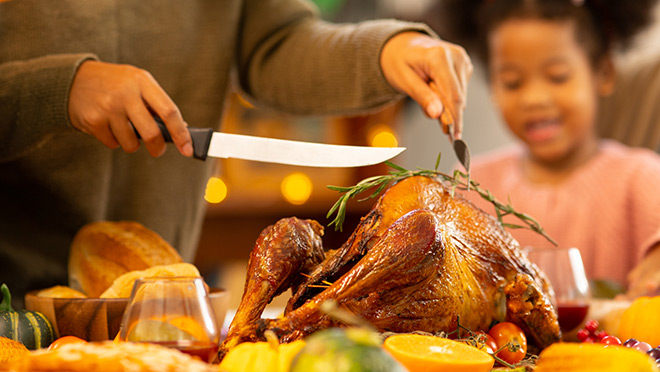Thaw meat, poultry, and fish the right way

Plan ahead, use the fridge, or do a quick-thaw carefully
The holiday turkey purchased a day before the big dinner that winds up thawing in a pan on the kitchen counter is a bacterial catastrophe waiting to happen. Don't take that risk.
Thawing meat in temperatures of 5°C or above is just an invitation for food-borne bacteria to multiply quickly. Thawing in the fridge starting days in advance is your best, safest bet. And if you need to quick-thaw, do it in ice water and take care to ensure the water stays very cold.
Here's what Health Canada has to say about thawing meat in particular:
- Place the meat in a clean container or platter that will hold any juices leaking out of the food. Place it on the bottom shelf of the refrigerator to prevent accidental cross-contamination of other food.
- Cook the meat as soon as it's defrosted.
Health Canada advises it will take about 24 hours for each 2.5 kg (5 pounds) of poultry. For most other meats, 24 hours in the fridge is usually enough.
Take precautions to ensure a thawed turkey and its juices don't spread around the kitchen. Wash your hands thoroughly with soap before and after handling a raw turkey, use a separate cutting board for the turkey, and never place food (fresh or cooked) on a plate or other surface that held raw turkey.
The quick method: ice water
Tossing your turkey in a sink filled with cold tap water isn't safe. Ensure you wrap your turkey in leak-proof plastic, and use ice to keep the water cool. It's still going to take a while – and you probably don't want to take the sink out of commission for an extended period. One great option is to use a large bucket – or preferably a cooler – to house the big bird in ice water.
How long will it take? The rule of thumb is about 30 minutes per pound, which adds up to about eight hours for a 16-pound bird. The necessity here is to monitor the water temperature regularly. Use a meat thermometer to ensure the water never rises above 4°C. Add ice to keep that temperature in the safe range.
If you use a microwave, cook immediately after
We're not talking turkey here (at least not a whole turkey). The microwave can be a handy quick-thaw method, but only if you plan to cook the meat right away.
Health Canada advises to double-check that all containers, lids and wraps going into the microwave are clearly marked as microwave-safe. That means no polystyrene trays, plastic wraps or cardboard boxes. Use a thoroughly cleaned container or platter to collect any juices that leak out of the food – you do not want to contaminate your microwave.
The defrost button on a microwave can be tricky, and epicurious.com says it can't be trusted. The website offers a detailed guide on thawing different meats, vegetables, and stews.
Did you know? The biggest haven for bacteria in your home could be your dishcloth. Studies have shown that many homeowners regularly re-use dishcloths – sometimes for days – before washing them. One study of U.S. and Canadian homes published in 2014 analyzed 82 dishcloths and found that coliform bacteria was present in nine of 10 of the hand towels.
